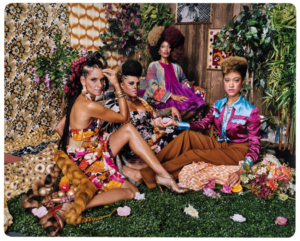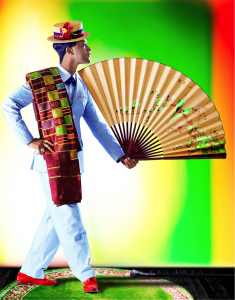
Mickalene Thomas’ “Racquel with Les Trois Femmes,” a 2018 chromogenic print, is a feminist re-imagining of “Le Déjeuner sur l’herbe” by Édouard Manet. (Wadsworth Atheneum)
The Stonewall riots of 1969 are generally regarded as the genesis of the modern gay rights movement, wherein our struggle for liberation became “seen” by the mainstream. But in art, as in life, visibility was just the first step. In the fifty years since Stonewall, a generation of artists challenged their newfound visibility, uncertain that it could adequately capture their marginalized experience, and strived to create radical, authentic modes of representation.
In Be Seen: Portrait Photography Since Stonewall, The Wadsworth Atheneum sets this aesthetic tradition firmly in the post-Stonewall historical legacy. Placing icons such as Cindy Sherman and David Wojnarowicz alongside less-recognized talents, the Wadsworth works to preserve these artists’ visions, as well as yield new insights for an emergent generation of LGBT Americans.
We spoke to co-curators Emily Handlin and Patricia Hickson about visibility, queer aesthetics, and the multimedia component of the exhibition. Be Seen is open until September 15, 2019—don’t miss it!
CT VOICE: As part of Be Seen, the Wadsworth has the privilege of exhibiting some of the most iconic photographers of American portraiture. Which artist in Be Seen do you feel is the most “underrated”—the one whose work is on par with the Peter Hujars and the Cindy Shermans, but who has been sadly underrecognized?
Emily Handlin: I would say Sage Sohier and John O’Reilly. Both artists have had solo shows in major museums and their works can be found in many important collections, but, the more I look at Sohier’s “At Home With Themselves” series and O’Reilly’s polaroid montages, the more I feel like they deserve much more attention than they’ve received.
Patricia Hickson: I have known about John’s work for some time, but Sage Sohier was new to me. Emily brought her work to the table.
CT VOICE: Be Seen takes the 1969 Stonewall Riots as an entry point for your exploration of queer portrait photography. What is it about Stonewall that you felt was the most powerful entry point? How do you see the legacy of Stonewall reflected in the work you’ve curated?
P: One word that I have heard associated with post-Stonewall repeatedly is “visibility.” As the LGBTQ+ community became more visible to society, the community also became more visible in art. Initially, we assessed the museum’s photography collection over one hundred years, fifty years before Stonewall and fifty years after Stonewall. There was a [newfound] strength in queer portrait photography in the subsequent years, which provided a focus for the exhibition. We acquired ten new works for the collection—both gifts and purchases—during the development of the exhibition. These new holdings brought diversity to this particular sub-collection.
In terms of the Stonewall legacy, it is notable that many of the sitters in the works meet the viewer’s gaze directly with self-confidence and strength. There is a power in these works that I see connected to post-Stonewall activism.
CT VOICE: Similar to the writings of Judith Butler, Be Seen surveys the performative aspects of queer identity—the way we “are,” and the measures we take to express this to the heteronormative world, whether by direct challenge or by playful subversion. What, in your opinion, is the difference between challenge and subversion? Do you think queer artists must choose one or the other, or should they be allowed to work in both modes?
E: I would argue that every subversion is a challenge. Just because a work is playful doesn’t mean that it isn’t also serious. I don’t think the two modes are hugely different. Ike Ude’s “Sartorial Anarchy” series, in which he combines pieces of masculine dress from different cultures and time periods, is playful, but it also neatly exposes just how contingent and slippery any definition of “masculine” and “feminine” really is.

Ike Ude’s “Sartorial Anarchy” explores masculinity through time and cultures. (Leila Heller Gallery)
CT VOICE: Along with the photo exhibition, the Wadsworth is also hosting a film series and public educational talks. How do these programs inform the photography? What would you say is the can’t-miss film/panel of Be Seen?
E: I’ll take this opportunity to plug a few other elements of the exhibition. The audio tour (“Be Heard”) gathers together the voices of twelve of the exhibition artists and seven members of the local LGBTQ+ community. In addition, a second audio tour (“Out on View: Queer Perspectives on the Collection”) tells queer stories about objects in the collection. It was important that we highlight not only the fact that queer art existed far before Stonewall, but also the fact that museums so often suppress their objects’ queer histories. The Wadsworth is certainly not innocent of this, and we thought it was important to do some institutional soul searching. To this end, the “Out on View” labels are now installed next to the permanent collection labels throughout the museum.
P: [Out on the View] is hosted by Dr. Andrew Lear on Saturday, July 13th and Saturday, August 24th at noon. Dr. Lear is a classics scholar and gay historian who worked with us to develop a queer tour across the collections at the Wadsworth, from antiquity to present. It extends the queer content of Be Seen into the other time periods and media in the European, American, and contemporary collection galleries. Dr. Lear has done informal versions of these tours at the MFA Boston and the Met in New York. They are fantastic!
E: The tours are free, but do require an RSVP. Please email faculty@wadsworthatheneum.org to reserve your spot.





More Stories
It’s a Bird! It’s a Goat! It’s a Furry!
Here She Is, Boys (And Everyone)… Here’s Varla!
Jelani Alladin: A Fellow Traveler On the Rise